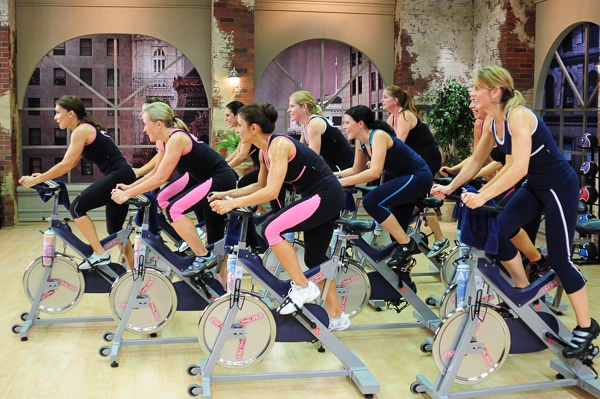
What is Low-Impact Exercise?
Low-impact exercise is an exercise where one foot stays on the ground. It doesn’t involve running, jumping or plyometrics where both feet leave the ground at the same time. Many high-impact workouts can be modified so that they’re low impact so that one foot always stays on the ground. You can even modify traditionally high-impact movements like jumping jacks so that one foot stays on the floor.
Some people confuse “impact” with “intensity.” Low-impact workouts don’t have to be low on the intensity scale. For example, a step workout can be intense even when you’re not taking both feet off the floor. During a step workout, you’re constantly moving up and down off the platform and using large muscles in your lower body. This burns calories and boosts your heart rate without jumping around. If you think low impact means easy, try my Low Impact series videos!
Indoor cycling workouts, like my XTrain Ride and Cycle Max videos, are another example of an exercise you can take to a high level of intensity without pounding your feet against a hard surface. In fact, these cycle workouts are not only low impact, but they’re also zero impact! The key is to do intervals at a higher resistance and pedal as fast as you can for short periods at different tempos and resistance. You can burn a significant number of calories doing low-impact workouts at a high intensity.
Why Would You Want to Do Low-Impact Workouts?
High-impact workouts place significant amounts of force on your feet and that force is transmitted to your joints. If you have osteoarthritis, exercise that pounds your joints can speed up the breakdown of cartilage and make the problem worse. But that doesn’t mean you should sit on the sidelines. Research shows that low-impact exercise helps to prevent osteoarthritis and is a good prescription for anyone who suffers from this common joint disease.
If you have an overuse injury, high-impact exercise may not be a safe option, but an indoor cycling workout on an exercise bike may be an acceptable alternative, depending on the type of injury you have. If so, it’s a way to maintain your fitness level until you’ve recovered. Doing an occasional low-impact workout can also help you avoid overuse injuries by taking some of the pressure off your muscles, tendons, ligaments, and joints.
Other situations where a low-impact workout works is when you took a break from exercise due to illness or surgery or immediately after pregnancy when you’re de-conditioned. It’s a way to “get back into it” without risking an injury. It’s also a good way to start if you’re new to exercising.
Finally, a low-impact workout is a good change of pace when you’re a burned out from too many plyometric and boot camp sessions. It’ll break up the monotony of doing the same old routine and work your body in a different way. That has its advantages. Changing your routine is also a good way to break through a plateau and begin seeing results again.
How to Make It Effective
If you’re doing a low-impact routine because you’re “burned out,” you may not want to work out at a high-intensity level. On the other hand, if you’re using it to get a challenging cardiovascular workout, you’ll need to up the resistance if you’re doing an indoor cycle workout or increase the speed.
If you’re doing a step workout, you can raise the step height or use dumbbells to increase the calorie burn for some exercises or exaggerate the movements by lifting your legs higher.
The Bottom Line?
Don’t confuse low-impact workouts with low-intensity. You can still get a good workout keeping one foot on the floor, and it’s a good way to work out when you don’t want to place extra stress on your joints or aggravate an injury. Even if you don’t have an injury or joint problems, an occasional low-impact workout is a nice change of pace and can help you avoid overuse injuries.
References:
ScienceDaily.com. “Light Exercise May Prevent Osteoarthritis, Study Suggests”
Related Articles By Cathe:
4 Common Myths About Low-Impact Exercise

